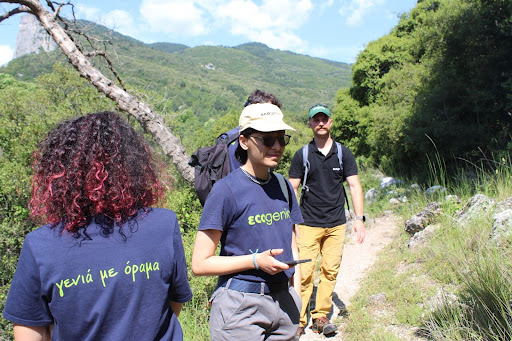
Adam Kokkinakis
Guest blog by Adam Kokkinakis, Cohort member in Ecogenia’s Olympus 2024 service project.
The initial idea
This past year, I had the opportunity to participate in Ecogenia NGO’s pilot civic service program in the Litochoro area, on the trails to Mt. Olympus. Our primary mission revolved around trail work and wildfire risk management. However I thought of using my background in biology to start a side project that would engage the community, help my team members understand the environment that we worked in, and contribute to scientific knowledge. I noticed a lack of biodiversity assessments in the area, so I thought that I could improve the knowledge about it using simple tools and methods that I, as a young biologist, am familiar with. Thus, the assessment that we started while maintaining the trails led us to a bigger citizen science project, which brought together volunteers, students, and the local community.
Through the help of my coordinators Lia Papazoglou and Vasilis Dimantopoulos, team members, and the knowledge of California Conservation Corps Alumna and wildlife specialist, Carrie Wendt, this project became a big part of our civic service time in the mountains.

iNaturalist: A tool for community engagement and collective knowledge
The iNaturalist app became our primary tool in this project. This platform allows users to record observations of plants, animals, and fungi using the camera of their smartphone and share them with a global community of naturalists, scientists, and enthusiasts. Through iNaturalist, our project “Mt. Olympus National Park and Region—Greece” transformed into a citizen science effort where each participant could contribute to a growing database of biodiversity on Mt. Olympus. Moreover, this project helped our team better understand the environment that we work in, and assess the way we interfere and preserve it, since we understood the common and rare species, their spatial distribution and their trends throughout a time of 3 months. This project could be repeated next year, so that we can compare the data of the distribution of the species.

Hosting hikes and trainings
In order to maximize our impact, we organized 5 training hikes, inviting volunteers with no or little experience, nature enthusiasts, scientists, and stakeholder groups in the area to join us. These hikes, or the so-called “Bioblitzes,” were educational trainings where participants learned how to use the iNaturalist app and other similar apps and gained knowledge about the local flora and fauna. They recorded every life form in the trails, and the community of iNaturalist’s open platform then helped with the identification of the species. On iNaturalist, we reached in total 286 observations and identified 184 different species! Combined with a Bioblitz for Natura 2000 Day on observation.org we managed to reach the number of more than 400 observations and identify more than 200 species! In total we managed to mobilize 67 volunteers and more than 100 naturalists contributed to the recognition of the observations on the app!

This experience helped on a personal and professional level too, since I learned how to lead a hike with an environmental education mission and got familiar with every life form that I’m interested in as a biologist. Continuing my academic journey with a Master’s degree that I’m starting this fall, I am sure that my experience with Ecogenia’s biodiversity assessments is only the start of more academic and educational projects hopefully with even higher impact, to me. My main interests are forest ecology, ecosystems science and conservation biology, sectors that are highly related with biodiversity assessments. So, I’m very happy that I had this chance and experience as a young scientist!

Our Impact
We hope that this initial assessment, though simple, provided a foundation for future research in the area. We hope that scientists now have more data to study, helping them understand the ecological dynamics of the area and informing conservation efforts. Our project demonstrates the incredible potential of citizen science to enhance scientific research and improve engagement in environmental education. By engaging volunteers and utilizing technology, we’ve shown that anyone can contribute to the understanding and conservation of the mountain.
We hope to see more initiatives like ours, where the curiosity to learn is combined with the expertise of young scientists, in order to protect biodiversity. Mt. Olympus, with its protected, diverse ecosystem, serves as a good example of what can be achieved when scientists, volunteers, the community, and stakeholders come together. Our project in Olympus will hopefully be the first of many citizen science activities incorporated into future Ecogenia service projects. The possibilities for cohort members to help advance this work and create bigger projects are endless.
If you’re inspired by our experience and want to be an active naturalist too, I encourage you to explore the iNaturalist website and app, make an account and search for local citizen science projects, environmental hikes and Bioblitzes!


